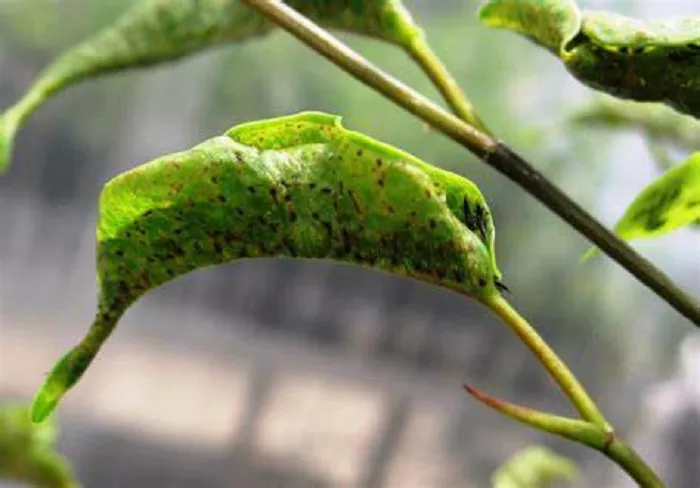Thrips are tiny, elusive pests that can wreak havoc on our beloved plants. Often overlooked due to their minuscule size, they leave behind telltale signs of their presence. From distorted leaves to speckled flowers, understanding what thrips look like on plants is crucial for any gardener. In this article, we will delve into the world of thrips, exploring their appearance, the damage they cause, and how to spot them before it’s too late. Armed with this knowledge, you can protect your garden and keep it thriving.
Identifying Thrips: A Closer Look
The Tiny Intruders
Thrips are incredibly small insects, usually measuring less than 3mm in length. Their elongated, slender bodies are often a pale yellow or brownish hue, making them difficult to spot with the naked eye. Under magnification, their wings appear fringed, a distinctive feature that sets them apart from other pests. These delicate, narrow wings allow them to move swiftly, often flying from plant to plant in search of new feeding grounds.
Signs of Thrip Infestation
Distorted Growth
One of the most noticeable signs of a thrip infestation is the distortion of new plant growth. Leaves may appear twisted, curled, or deformed. This happens because thrips feed on the tender tissues of young leaves and buds, disrupting their normal development. The damage is often more pronounced on the undersides of leaves, where thrips tend to congregate.
Silvery Specks and Stippling
When thrips feed, they pierce plant cells and extract the contents, leaving behind tiny, silvery specks. These specks are the result of the cell contents being removed, and they can accumulate on the surface of leaves and petals. Over time, this stippling effect can give the plant a mottled appearance, reducing its aesthetic appeal and potentially affecting its health.
Black Fecal Deposits
Another telltale sign of thrip activity is the presence of small, black fecal deposits. These tiny droppings are left behind as thrips feed and can be found on leaves, stems, and even flowers. The presence of these deposits is a clear indication that thrips have been active in the area and are likely still present.
Lifecycle and Behavior
The Lifecycle of Thrips
Understanding the lifecycle of thrips is essential for effective control. Thrips undergo a process called metamorphosis, which includes several stages. They start as eggs, which are typically laid in plant tissues. These eggs hatch into larvae, which feed voraciously on plant material. After a period of feeding, the larvae enter a pupal stage, where they transform into adults. The entire lifecycle can be completed in as little as two weeks, depending on environmental conditions.
Feeding Habits
Thrips are voracious feeders, targeting a wide range of plants. They are particularly fond of flowers, where they can cause significant damage to petals and buds. Their feeding habits can lead to discolored or deformed flowers, which can be particularly disappointing for gardeners who have spent time nurturing their blooms. Thrips also feed on leaves, stems, and fruits, making them a versatile and destructive pest.
Spotting Thrips Early
Regular Inspections
The key to managing thrip infestations is early detection. Regularly inspecting your plants, especially the undersides of leaves and within flower buds, can help you spot thrips before they cause extensive damage. Use a magnifying glass to get a closer look at any suspicious areas. Look for the telltale signs of thrip activity, such as silvery specks, black fecal deposits, and distorted growth.
Monitoring Techniques
In addition to visual inspections, there are several techniques you can use to monitor for thrips. Yellow sticky traps can be placed near susceptible plants to attract and capture adult thrips. These traps can help you detect the presence of thrips early and give you an idea of the population size. Regularly checking these traps can provide valuable information about thrip activity in your garden.
Managing Thrip Infestations
Biological Controls
One of the most effective and environmentally friendly ways to manage thrip infestations is through biological controls. Introducing natural predators, such as predatory mites or lacewings, can help keep thrip populations in check. These beneficial insects feed on thrips, reducing their numbers without the need for chemical interventions.
Cultural Practices
Implementing good cultural practices can also help reduce the likelihood of thrip infestations. Keeping your garden clean and free of debris can eliminate potential hiding spots for thrips. Regularly removing weeds and dead plant material can also help reduce the risk of thrip populations becoming established. Additionally, ensuring that your plants are well-watered and healthy can make them less attractive to thrips.
Chemical Controls
In some cases, chemical controls may be necessary to manage severe thrip infestations. Insecticidal soaps and horticultural oils can be effective against thrips, especially when used in combination with other control methods. These products work by suffocating or dehydrating the insects. However, it is important to use these products carefully and follow the manufacturer’s instructions to avoid harming beneficial insects.
Preventing Future Infestations
Plant Selection
Choosing plants that are less susceptible to thrip infestations can help reduce the risk of future problems. Some plants, such as certain varieties of roses and marigolds, are more resistant to thrips. Researching and selecting these varieties can help create a more resilient garden.
Companion Planting
Companion planting can also be an effective strategy for preventing thrip infestations. Certain plants, such as basil and lavender, are known to repel thrips. Planting these companion plants near susceptible crops can help deter thrips from taking up residence in your garden.
Conclusion
Thrips may be small, but their impact on plants can be significant. By understanding what thrips look like and the signs of their presence, gardeners can take proactive steps to protect their plants. Regular inspections, biological controls, and good cultural practices are all essential tools in the fight against thrips. With careful management and vigilance, you can keep your garden healthy and thriving, free from the damage caused by these tiny pests.


